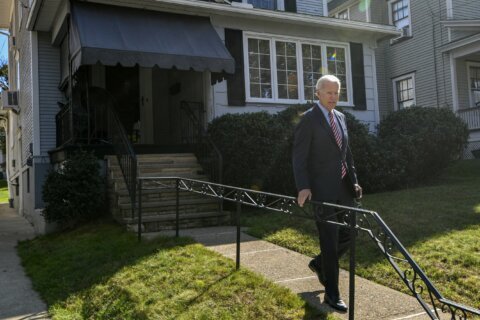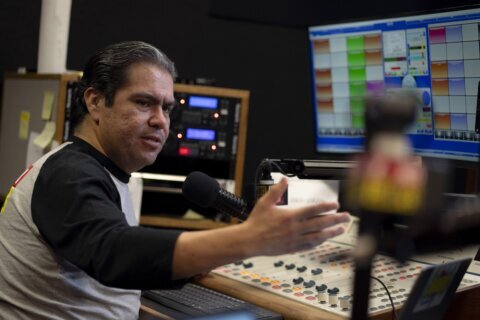This year’s election could prove one of the most dizzying and drawn-out in at least a decade, with election experts and officials alike preparing the public for a slow grind.
A flood of mail-in ballots, staffing shortages at polling places, rhetoric that acts to delegitimize the vote and the possibility that legal challenges could pile on in key battleground states are among factors threatening to muddy the waters starting Nov. 3.
It could take days to tally the vote, which would put 2020 in the same pantheon of cutthroat suspense as the 2000 election, which dragged on for around a month. But the coronavirus pandemic could mean the process would take markedly longer this time around, with the possibility that there will be votes yet to be counted in December — when the Electoral College normally meets to formally elect the next president.
“People are going to have to be very patient on election night and in the days afterward,” WTOP Capitol Hill correspondent Mitchell Miller said. “Many of the experts are saying we, in the media, need to make it clear to American voters that this really is a very, very different election.”
If it were any other year, election night would go along these lines: Precincts would start aggregating and reporting their results early in the evening, during which the media would caution that early totals could skew Democratic or Republican. The bigger picture, they’d likely say, would become clearer as the night brings with it a more even blend of urban and rural demographics.
A large volume of absentee and mail-in ballots means it’s more likely than not that this year’s process will stretch on for a while. Even though early voting has started, some states can’t begin to tally their ballots until polls close on Election Day, including key battlegrounds Pennsylvania, Michigan, Wisconsin and New Hampshire — all of which were crucial to President Donald Trump’s Electoral College victory in 2016, a win his current campaign is trying hard to replicate.
Maryland tweaked its law so counties can tabulate mail-in ballots starting Oct. 1, after delays during its summer primary. The District will not count votes until polls close, but can verify beforehand that the voter signed them to speed up the process. Virginia’s policy is more vague, allowing votes to be counted before Election Day “as needed to expedite counting absentee ballots,” according to the National Conference of State Legislatures.
Most people are probably going to vote using a different method than in years past: More voters are planning to vote early than in other elections, according to a recent AP-NORC poll of over 1,100 registered adults. The poll also suggested that the number of completed mail-in ballots will dwarf in-person early voting.
Mail-in ballots around the country
A delayed vote will also open the door to legal battles, conspiracy theories and misinformation. But American history has demonstrated that anomalies are not without precedent, and a slow or contested count shouldn’t immediately be construed as a sign of error or outright malice. And while having mail-in as the primary voting option might be new to some states, others can boast a long history of success with it.
Oregonians have voted exclusively by mail in every election since 1998. If states are taken to be America’s labs of democracy, Oregon could serve as a strong case study that mail-in voting can be conducted safely and securely on the state level with higher turnout than usual, yet no discernible impact from voter fraud.
“When I asked people what they like best about it, almost all of them said they feel they cast a more informed vote, on their time schedule and on their terms,” Phil Keisling, who served as Oregon’s secretary of state in the 1990s, told Oregon Public Broadcasting.
But most states aren’t nearly as well-versed in managing such a high volume of mail-in ballots. Florida and Arizona, both hotly contested, are allowing ballots to be counted ahead of Election Day to alleviate pressure once the polls close.
Yet Wisconsin — where Trump won over Clinton by fewer than 23,000 votes, but polls are looking sunny for former Vice President Biden as of late — is already host to a protracted legal battle between Democrats and Republicans on whether or not to grant an extension for counting absentee ballots amid long lines, fewer polling places and a shortage of polling workers.
Wisconsin has so far fielded more than 1.1 million absentee ballot requests, in a state where elections are run by municipalities instead of counties. In some locations, the burden of aggregating thousands of votes could fall to a single clerk. Similar delays could also befall Pennsylvania, where about half its counties were still working through their vote a week after this season’s primary. And Georgia, which could be in play for the first time in two decades, bungled its own primary.
The backlog of votes and the time it takes to count them only form part of the picture. Social media abhors a vacuum, and any drawn-out counting period will in all likelihood be filled in with an array of baseless conspiracies — some of which the president has already been laying the groundwork for.
“Rhetoric will, as it always does with politics, play a role with how the people accept or don’t accept the results of this election,” Miller said.
“If their candidate appears to be losing, there’s a good chance they will think something is wrong, and that’s where it’s really going to be important for state and federal election officials to be very transparent about what is happening, and for those of us in the media to clearly explain what is happening.”
‘Something none of us have ever experienced’
In a worst-case scenario, where results are stalled for weeks and disinformation runs rampant, it will be up to state and local officials to be a voice of reason. Maryland and Virginia have been proactive in gearing up for that eventuality.
“The combination of a presidential election year and a pandemic is something none of us have ever experienced,” Virginia Gov. Ralph Northam said during a Sept. 15 news conference, at which point the state had received 790,000 absentee ballot requests, with demand already having far eclipsed that seen in the 2018 midterms.
“It’s important to know that Virginia law allows election officials to pre-process absentee ballots as they come in, which means we don’t have to wait until election night to begin,” he added. “That said, everyone should be prepared to wait a few days to know the results of the presidential election … for the process to work, it’s better to get an accurate count than a fast one.”
But in a chaotic election season, the D.C. region has been no stranger to voting hurdles. Maryland’s primary was bogged down with long lines and late ballots, prompting state officials to expand the availability of drop-off boxes and voting centers come November.
Maryland officials scrambled to issue a clarification earlier this month after the Postal Service mailed out generic how-to postcards that conflicted with the state’s own requirements for submitting a ballot application.
Diminishing faith in the U.S. Postal Service has also contributed to lengthy lines in Northern Virginia, with Northam seeking to alleviate fears over the Postal Service’s inadequacy by making it possible to track a ballot’s progress online.
Thus far, the local reaction has been two-pronged: Ensure that people can safely vote, and trust their vote, too.
“Their biggest concern is there being actual doubt among people about whether or not their vote gets counted,” Miller said. “People have to believe in the certainty of the vote — even though it’s a cliché, you want to make sure that your vote actually counts.”








